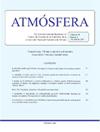The Planetary Boundary Layer physical processes, the secondary thermal baroclinic circulation and inertial oscillation contribution to diurnal variation of the Etesian winds over the Aegean Sea
IF 1
4区 地球科学
Q4 METEOROLOGY & ATMOSPHERIC SCIENCES
引用次数: 0
Abstract
The Etesian winds constitute an important climatological phenomenon, which does not only moderate the heat during the summer in the Aegean Sea, but provide a source of clean renewable energy as well. Even though several papers have attempted to explain their dynamical and the physical characteristics, the respective processes that drive the diurnal variation of the wind speed are not fully understood. The objective of this paper is to identify the processes responsible for diurnal variation with observed maximum wind speed around noon and minimum around midnight. Analytical solutions of a primitive equation set in Eulerian form, after introducing suitable conditions and approximations, reveal an inertial oscillation over the Aegean Sea. Data based on direct observations, ECMWF IFS high resolution analyses and high-resolution simulations with the Weather Research and Forecasting (WRF) model are utilized to find out the type and the structure of the Planetary Boundary Layer (PBL) over the Aegean Sea. This PBL appears to be of a marine character and turbulent mostly during the day but less during the night. The direct impact of the local and regional thermally-driven circulations is found to be the main cause of the diurnal variation of the observed wind and partly the inertial oscillation. Results from numerical simulations certify these findings. Furthermore, the momentum and Newtonian heating exchanges by the physical processes inside the PBL, where the gradient wind together with smaller scales of atmospheric motions exist, are also necessary for explaining the variability of the Etesian winds.行星边界层物理过程、次级热斜压环流和惯性振荡对爱琴海埃提斯风日变化的贡献
埃提斯风构成了一种重要的气候现象,它不仅在爱琴海的夏季缓和了热量,而且提供了一种清洁的可再生能源。尽管有几篇论文试图解释它们的动力学和物理特征,但驱动风速日变化的各自过程尚未完全了解。本文的目的是找出造成正午前后最大风速和午夜前后最小风速日变化的过程。在引入适当的条件和近似后,欧拉形式的原始方程集的解析解揭示了爱琴海上空的惯性振荡。利用直接观测资料、ECMWF IFS高分辨率分析和WRF模式的高分辨率模拟,研究了爱琴海行星边界层的类型和结构。这个PBL似乎具有海洋特征,主要在白天湍流,但在夜间较少。局部和区域热驱动环流的直接影响是观测风的日变化的主要原因,部分原因是惯性振荡。数值模拟的结果证实了这些发现。此外,在边界层内存在梯度风和较小尺度大气运动的物理过程中,动量和牛顿热交换也是解释埃提斯风变异性的必要条件。
本文章由计算机程序翻译,如有差异,请以英文原文为准。
求助全文
约1分钟内获得全文
求助全文
来源期刊

Atmosfera
地学-气象与大气科学
CiteScore
2.20
自引率
0.00%
发文量
46
审稿时长
6 months
期刊介绍:
ATMÓSFERA seeks contributions on theoretical, basic, empirical and applied research in all the areas of atmospheric sciences, with emphasis on meteorology, climatology, aeronomy, physics, chemistry, and aerobiology. Interdisciplinary contributions are also accepted; especially those related with oceanography, hydrology, climate variability and change, ecology, forestry, glaciology, agriculture, environmental pollution, and other topics related to economy and society as they are affected by atmospheric hazards.
 求助内容:
求助内容: 应助结果提醒方式:
应助结果提醒方式:


